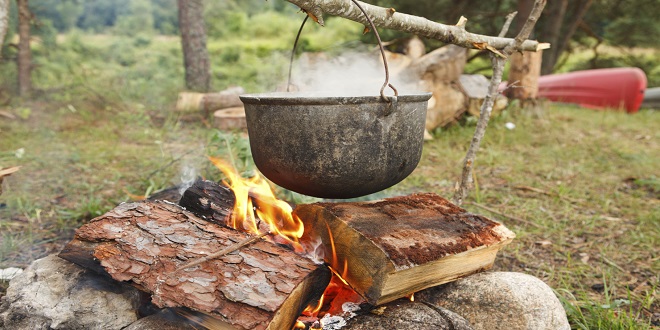Hunting, Gathering, and Stone Age Cooking

Hunting-Gathering Life
Ninety percent of humans who have ever lived were gatherers and hunters. Although hunter-gatherers were more closely tied to the larger ecosystem along with other animals, it would be wrong to assume that they lived in some kind of primeval harmony with nature. They destroyed fields through burning, hunted animals to extinction, and caused pollution.
To capture or kill an animal requires a high level of sophistication. Making such tools as bows and arrows are skills that are passed down from generation to generation. Presumably, these skills give some peoples an evolutionary advantage over others, and this may be why we replaced Neanderthals. Sophisticated toolmakers survive and pass on their genes at a greater rate.
Boiling Water in a Paper Bag
Here’s an interesting exercise that simply shows how one can cook in an animal skin. Take a large paper shopping bag, and cut out an eight-by-eight inch square with no seams. (Seams would cause it to leak.) Fold it in half diagonally once into a triangle, and then fold it again in half into a smaller triangle. Open it up so that you have a cone, and tape or staple the ends so that it doesn’t unfold. Notice that one side will be thicker than the other; that’s fi ne, it will hold water. Next, fill the cone halfway up with water, and place it immediately over a burning candle. In a few minutes, the water inside will boil, and the paper will not burn. This replicates the technique of cooking in an open skin stretched over a fi re. If you have the patience, try cooking a carrot in the boiling water.
Read Also: Masstamilan
Pit Cooking
To get a sense of how people cooked in prehistoric times, first find an open spot with soil soft enough to dig, at least 20 feet from any trees or buildings. Dig a circular hole about three feet deep. Line the perimeter of the pit with large stones for safety purposes and so that you can balance sticks across the pit. Make a fi re inside the pit, starting with small kindling and building up to larger logs. When they have burned down to coals, you can start cooking. This is the original way to barbecue, incidentally.
You want to cook long and slow, but because this is before the discovery of metallurgy, you need to make a lattice using fresh green sticks. Lay them across the pit in one direction, and then lay more in the other direction so that you have a kind of primitive grill. They should be far enough away from the hot coals so that they don’t burn, but they probably will chair a little.
Place on top of the sticks any meat you prefer: a few split chickens, large cuts of pork shoulder, or even a fish wrapped in sturdy leaves. Your seasoning should be minimal—whatever herbs you can fi nd and salt. Because you are using a very gentle fi re, expect larger pieces of meat to cook for at least an hour or so.
The tattoo culture has experienced a significant rise in popularity over the years, becoming more mainstream and widely accepted. Tattoos have a long and rich history, serving as a form of self-expression and a symbol of cultural significance. From ancient civilizations to modern times, tattoos have held various meanings and purposes.
Last word
If you have a flare-up, you can always sprinkle a little water on the fie to prevent the meat from burning. It will smoke a lot, which is good. Smoke is unquestionably a major flavor category that we have learned to enjoy in the millennia of cooking in this way
Feel Free to Read More: Isaimini

